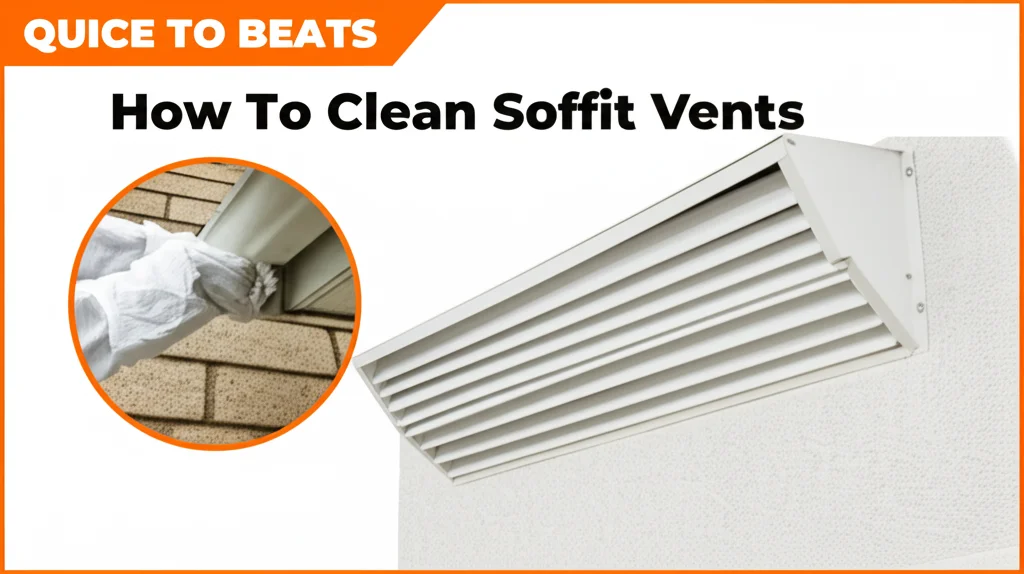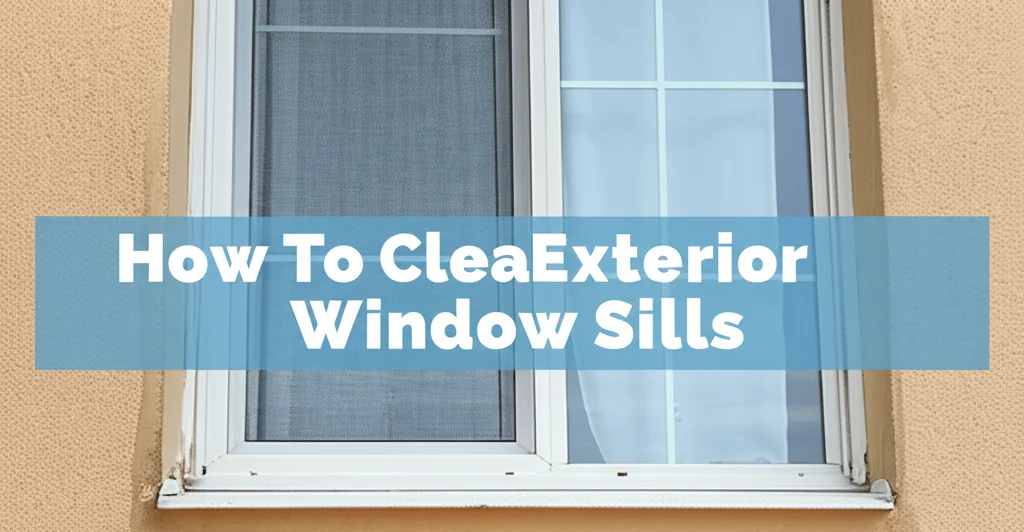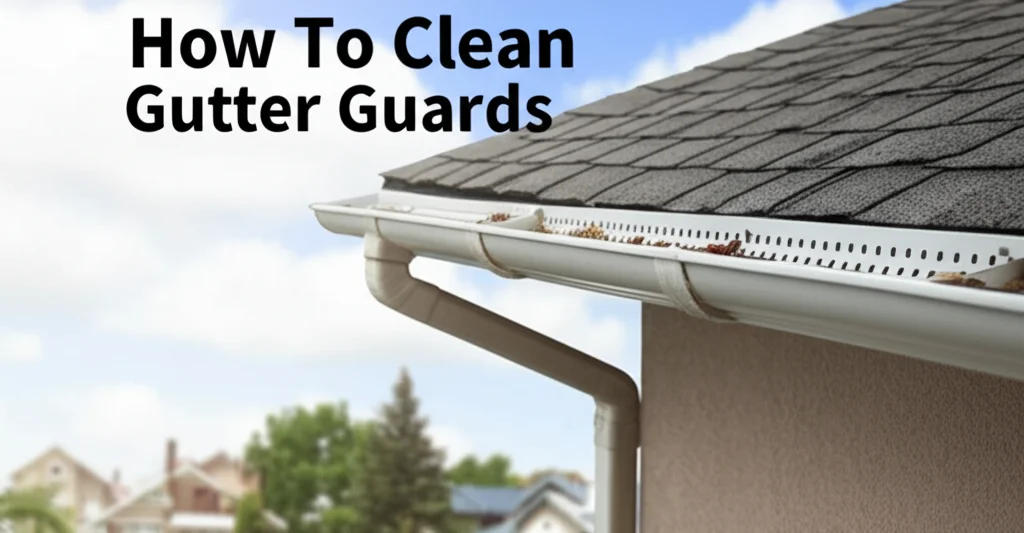· Home Maintenance · 8 min read
How To Clean Soffit Vents

Keeping Your Home Breathing: How To Clean Soffit Vents
Have you ever thought about what’s happening up there – under your eaves? Soffit vents, often overlooked, are crucial for your home’s health. They allow air to circulate in your attic, preventing moisture buildup and regulating temperature. When these vents become clogged with leaves, debris, or even pest nests, it can lead to serious problems like mold growth, wood rot, and increased energy bills. This article will guide you through how to clean soffit vents effectively, ensuring your home stays well-ventilated and protected. We’ll cover everything from safety precautions to the best tools and techniques for a thorough cleaning. Properly maintained soffit vents contribute to a healthier, more energy-efficient home.
Quick Answer: To clean soffit vents, safely access them with a ladder, remove visible debris by hand, use a brush or vacuum attachment to dislodge stubborn material, and consider installing vent guards to prevent future blockages.
Takeaway:
- Regularly cleaning your soffit vents prevents costly damage.
- Safety is paramount when working at heights.
- Preventative measures like vent guards save time and effort.
Why Cleaning Soffit Vents Matters
Let’s start with the “why.” Why bother with these often-hidden vents? The answer is simple: proper ventilation is vital for your home’s structural integrity and your family’s comfort. Soffit vents work in tandem with ridge vents (located at the peak of your roof) to create a natural airflow. This airflow carries away moisture produced by cooking, showering, and even breathing. Without this airflow, moisture can accumulate, creating a breeding ground for mold and mildew.
Here’s a breakdown of the issues caused by clogged soffit vents:
- Mold and Mildew Growth: Moisture trapped in the attic encourages mold and mildew, which can cause health problems and damage building materials.
- Wood Rot: Prolonged exposure to moisture weakens wood, leading to rot and potentially compromising the structural integrity of your roof and eaves.
- Increased Energy Bills: A poorly ventilated attic can become excessively hot in the summer and cold in the winter, forcing your HVAC system to work harder and increasing your energy consumption.
- Pest Infestations: Clogged vents provide easy access for birds, squirrels, insects, and other pests to build nests in your attic.
- Reduced Roof Lifespan: The combination of moisture, rot, and pest damage can significantly shorten the lifespan of your roof.
Safety First: Preparing to Clean Your Soffit Vents
Before you even think about grabbing a ladder, safety needs to be your top priority. Working at heights always carries risks, and it’s crucial to take precautions to prevent falls and injuries. Remember, a quick cleaning isn’t worth a trip to the emergency room.
Here’s a safety checklist:
- Use a Sturdy Ladder: Choose a ladder that’s tall enough to reach your soffit vents comfortably without overextending. Ensure the ladder is placed on a level surface and is securely positioned.
- Wear Appropriate Footwear: Wear shoes with good traction to prevent slipping on the ladder or the roof.
- Wear Gloves: Protect your hands from dirt, debris, and potential insect stings.
- Wear Eye Protection: Safety glasses or goggles will shield your eyes from falling debris.
- Work with a Partner: If possible, have someone spot you while you’re on the ladder.
- Avoid Windy Conditions: Do not attempt to clean your soffit vents on a windy day.
- Be Aware of Power Lines: Maintain a safe distance from any overhead power lines.
Tools You’ll Need for Effective Soffit Vent Cleaning
Having the right tools makes the job much easier and more efficient. You don’t need a lot of fancy equipment, but a few key items will make a big difference. Gathering everything beforehand will streamline the process.
Here’s a list of recommended tools:
- Ladder: As mentioned above, a sturdy and appropriately sized ladder is essential.
- Gloves: Protect your hands.
- Safety Glasses: Protect your eyes.
- Brush: A long-handled brush (like a chimney brush or a stiff-bristled scrub brush) is ideal for dislodging debris.
- Vacuum with Attachments: A shop vacuum with a hose attachment can be used to suck up loose debris. Consider a narrow crevice tool for reaching into tight spaces.
- Screwdriver: You may need a screwdriver to remove vent covers or screens.
- Vent Guards (Optional): These are mesh screens that prevent debris from entering the vents in the future. We’ll discuss these in more detail later.
- Garden Hose with Spray Nozzle (Optional): A gentle spray can help loosen stubborn debris, but use caution around electrical components.
Step-by-Step Guide: Cleaning Your Soffit Vents
Now that you’re prepared, let’s get to the cleaning! Follow these steps for a thorough and effective cleaning process. Take your time and work carefully.
- Inspect the Vents: Start by visually inspecting the vents to assess the amount of debris and identify any potential problems, such as damaged vent covers or signs of pest activity.
- Remove Visible Debris: Using your hands (with gloves on!), carefully remove any large pieces of leaves, twigs, or other debris that are visible.
- Brush Away Stubborn Debris: Use the long-handled brush to dislodge any debris that’s stuck inside the vents. Work in a sweeping motion to loosen the material.
- Vacuum Up Loose Debris: Use the shop vacuum with the hose attachment to suck up the loosened debris. Pay attention to corners and crevices. If you’re using a wet/dry vac, ensure it’s set to dry mode.
- Check for Pest Nests: Look for signs of bird or insect nests. If you find a nest, carefully remove it, taking precautions to avoid disturbing any remaining insects. You might need to consult a pest control professional if you suspect a significant infestation.
- Reinstall Vent Covers: If you removed any vent covers or screens, reinstall them securely.
- Repeat for All Vents: Repeat the process for all the soffit vents around your home.
Preventing Future Clogs: Installing Vent Guards
Cleaning your soffit vents is important, but preventing them from clogging in the first place is even better. That’s where vent guards come in. These mesh screens fit over the vents, allowing airflow while blocking leaves, debris, and pests. Installing vent guards is a relatively simple and inexpensive way to save yourself time and effort in the long run.
There are several types of vent guards available:
- Plastic Vent Guards: These are the most affordable option, but they may not be as durable as metal guards.
- Metal Vent Guards: These are more durable and provide better protection against pests.
- Foam Vent Guards: These are easy to install and provide good airflow, but they may need to be replaced more frequently.
Choose the type of vent guard that best suits your needs and budget. Follow the manufacturer’s instructions for installation. You can find vent guards at most hardware stores and home improvement centers. Consider this a small investment that will pay off in the long run, potentially saving you from costly repairs. You can also find more information on maintaining your home’s exterior at https://www.beacleaner.com/how-to-clean-outside-windows-upstairs/.
When to Call a Professional
While cleaning soffit vents is a DIY-friendly task, there are situations where it’s best to call a professional. If you’re uncomfortable working at heights, have a large or complex roof, or suspect significant damage to your soffit or fascia, it’s best to leave the job to the experts. A professional roofing contractor can safely and effectively clean your soffit vents and identify any underlying problems that need to be addressed. They can also offer advice on preventative maintenance to keep your roof in good condition. If you notice signs of mold or water damage, it’s also important to consult a professional to assess the extent of the damage and recommend appropriate remediation measures. Don’t hesitate to seek professional help if you’re unsure about any aspect of the cleaning process.
FAQ: Your Soffit Vent Cleaning Questions Answered
Q: How often should I clean my soffit vents?
A: Ideally, you should clean your soffit vents at least twice a year – once in the spring after the leaves have fallen and once in the fall before the winter weather sets in. However, if you live in an area with a lot of trees, you may need to clean them more frequently.
Q: Can I use a pressure washer to clean my soffit vents?
A: While a pressure washer could be used, it’s generally not recommended. The high pressure can damage the vents and force water into your attic, potentially causing more problems. A gentle spray from a garden hose is a safer option.
Q: What if I find a dead animal in my soffit vent?
A: Dealing with a dead animal requires caution. Wear gloves and a mask to protect yourself from potential diseases. Carefully remove the animal and dispose of it properly. Disinfect the area thoroughly. If you’re uncomfortable handling the situation, contact a pest control professional.
Q: Are soffit vents necessary?
A: Yes, soffit vents are essential for proper attic ventilation. Without them, your attic can become overheated in the summer and prone to moisture buildup, leading to a variety of problems.
Q: What are the signs that my soffit vents are clogged?
A: Signs of clogged soffit vents include high energy bills, visible mold or mildew in the attic, peeling paint on the exterior of your home, and pest infestations.
Breathe Easy: Maintaining Your Home’s Ventilation
Cleaning your soffit vents is a simple yet crucial task for maintaining a healthy and efficient home. By following the steps outlined in this guide, you can prevent costly damage, improve your home’s energy efficiency, and create a more comfortable living environment. Remember to prioritize safety, use the right tools, and consider installing vent guards to prevent future clogs. Regular maintenance, like cleaning your soffit vents, is a key component of responsible homeownership. If you’re looking for more ways to keep your home clean and well-maintained, check out our guide on https://www.beacleaner.com/how-to-clean-basement-rafters/ for tackling those often-overlooked areas. Don’t let clogged soffit vents compromise your home’s health – take action today!




